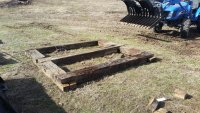- Thread starter
- #1,601
Senile_Texas_Aggie
Herd Master
I HATE GREENBRIARS!!!!!!!!!!!!!!!
Miss @Baymule, I was thinking of you as I pulled them down from the trees...
Sounds like alot of work @Senile_Texas_Aggie . Good for you both. It is really nice that the two of you seem to enjoy working together on those projects. And yes, PLEASE be careful.....
Yes, we do enjoy making our place look nicer. It is slow going but the effort is worth it. And I will be as careful as my Senile Texas Aggie I/Q will let me...
This morning I started work on building a bridge. My plan is to assemble it all here at the shop and then carry it down to the ditch using the tractor. My assembly plan is to have 3 railroad cross ties running lengthwise along the direction of travel and 2 cross ties, 1 at each end. On top, running from side to side I plan to have pressure treated 2x4s. I plan to notch the cross ties so that I can bolt them together. I managed to get the 2 end cross ties notched. You talk about work! I had to sharpen the chainsaw 3 times to get the cutting done!
 That took all morning. Next will be notching the 3 cross ties that will run lengthwise. Have any of you cut cross ties before with a chainsaw? Did you know they were that hard? I certainly did not.
That took all morning. Next will be notching the 3 cross ties that will run lengthwise. Have any of you cut cross ties before with a chainsaw? Did you know they were that hard? I certainly did not.Also, do you think that 2x4s will be strong enough to support a tractor? I am hoping that they will. With the cross tie in the middle, I am hoping that the stress on them won't be too great. I guess I will find out the first time I drive across it!
Senile Texas Aggie


